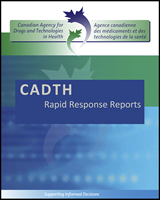Technologies Assisting in Remote Consultations for the Diagnosis of Stroke: A Review of the Clinical Evidence
Rapid Response Report: Summary with Critical Appraisal
In Canada, strokes are responsible for approximately 16,000 deaths per year, making it the fourth highest cause of death. For non-fatal cases, the burden associated with stroke is heavy for both patients and caregivers due to long-term disability, lowered ability to perform daily tasks, the cost of care, and lost productivity. Strokes can be hemorrhagic or ischemic, with ischemic strokes accounting for approximately 80% of all strokes. In order to decrease the burden and increase positive outcomes for patients with acute stroke, rapid assessment and treatment is important.
One treatment option for acute ischemic stroke is systemic thrombolysis treatment, using tissue plasminogen activator (tPA). Thrombolysis treatment dissolves the clot that is obstructing blood flow to the brain, preventing permanent damage and is therefore associated with favourable outcomes. There is a narrow treatment window for thrombolysis treatment; it must be delivered within three hours of symptom onset, and it requires specific neurological expertise in order to guide the decision-making regarding ideal candidates for the treatment. As most stroke experts are located in major centres, patients in rural or remote areas are unlikely to receive thrombolysis treatment unless remote physicians are able to liaise with stroke experts in order to help guide decision-making and treatment planning. Telehealth and telemedicine are options used in order to link remote physicians with experts for this purpose.
Telehealth and telemedicine can include telephone consultation, the transfer of digital imaging results via email or secure website, videoconferencing where the clinical encounter is guided by a stroke expert in a stroke centre, and various combinations of these modalities. This report will review the clinical evidence available regarding technologies used that assist with remote consultations for the diagnosis and treatment planning for patients presenting with symptoms of acute stroke or transient ischemic attack.
Disclaimer: The Rapid Response Service is an information service for those involved in planning and providing health care in Canada. Rapid responses are based on a limited literature search and are not comprehensive, systematic reviews. The intent is to provide a list of sources of the best evidence on the topic that CADTH could identify using all reasonable efforts within the time allowed. Rapid responses should be considered along with other types of information and health care considerations. The information included in this response is not intended to replace professional medical advice, nor should it be construed as a recommendation for or against the use of a particular health technology. Readers are also cautioned that a lack of good quality evidence does not necessarily mean a lack of effectiveness particularly in the case of new and emerging health technologies, for which little information can be found, but which may in future prove to be effective. While CADTH has taken care in the preparation of the report to ensure that its contents are accurate, complete and up to date, CADTH does not make any guarantee to that effect. CADTH is not liable for any loss or damages resulting from use of the information in the report.
Copyright: This report contains CADTH copyright material and may contain material in which a third party owns copyright. This report may be used for the purposes of research or private study only. It may not be copied, posted on a web site, redistributed by email or stored on an electronic system without the prior written permission of CADTH or applicable copyright owner.
Links: This report may contain links to other information available on the websites of third parties on the Internet. CADTH does not have control over the content of such sites. Use of third party sites is governed by the owners’ own terms and conditions.
Except where otherwise noted, this work is distributed under the terms of a Creative Commons Attribution-NonCommercial- NoDerivatives 4.0 International licence (CC BY-NC-ND), a copy of which is available at http://creativecommons.org/licenses/by-nc-nd/4.0/
